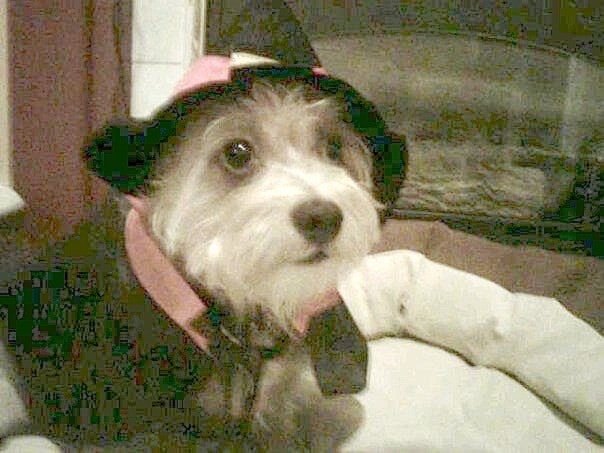Halloween brings delicious treats and ghostly fun for humans but many dogs experience fear at this time of year. Dogs become stressed due to fireworks and costumed children and may run away or become destructive by digging and chewing. “When I was growing up, our dog was so scared of fireworks that she would bury herself in the dark corner of our laundry room, under a pile of blankets,” recalls Michelle Sevigny, author of Dogsafe: Everything Your Dog Wants You to Know in an Emergency.
“Luckily she didn’t become destructive to the point of hurting herself but many dogs do.”
There are also interesting items that your dog may explore and which puts his safety at risk. Sevigny suggests tips to keep your dog safe:
1. Increase your dog’s exercise and walk him earlier in the day before the kids are out trick-o-treating. If your dog is exhausted, she has less pent up energy in which to react to the startling fireworks and freaky costumes.
2. Pumpkin carving supplies including felt tip pens, sharp plastic or metal knives and candles and kids’ costume pieces may be enticing to dogs and cause vomiting, diarrhea or cuts to the mouth if eaten or result in choking or intestinal blockages if your dog chews or ingests the solid objects. Keep your dog away from the carving table, clean up the table and floor after decorating and keep the carved pumpkin, especially one that has a lit candle, out of your dog’s reach. Allow your dog to check out the costumes ahead of time by smelling them and seeing them on your children before the big night and they are already stressed.
3. Keep your dog away from the door during trick-o-treating. Give your dog a raw bone in another room or at the very least, use a leash attached to prevent door dashes. Also avoid parks, school yards and other public spaces where fireworks may be set off. Never force your dog into an area where fireworks are being set off in attempt to flood them with the high intensity noise.
4. Make sure your dog wears an ID tag, with current information, in case she manages to escape. Check that your dog’s collar is tight enough to avoid it slipping off suddenly.
5. Help your dog relax by imitating canine calming signals. Repeatedly yawning and licking your lips while sitting beside your dog mimics what dogs do to calm down themselves or another dog. Or try natural calming products such as Rescue Remedy, commonly found in health food stores.
6. Leave your dog at home while accompanying trick-o-treating children. While it may be nice to have your four-legged family member along, dogs may become frightened of costumed children, spooky skeletons and other scary yard decorations.
7. Change the environment to lessen the effects of fireworks. Close outside doors to reduce sound and close curtains or blinds to reduce any flashing light show.
If your dog is crate trained, line the crate with noise dampening blankets inside and out. Use noise reducing ear protection specifically designed for canines.
8. Keep chocolate treats out of your dog’s reach as chocolate contains an ingredient called theobromine which may cause vomiting, diarrhea, panting, excessive thirst, hyperactivity, tremors or even death. If candy wrappers or lollipop sticks are ingested, choking or intestinal blockages may occur.
9. If you dress your dog in a costume, make sure it doesn’t restrict his vision, hearing or movement. Never leave your dog unattended as he may chew at the costume or get caught on objects. Have fun with the costumes but respect your dog’s level of comfort and stress.
10. Be mindful of discarded Halloween items strewn about your normal dog walking route, before and after the big night. Smashed pumpkins, candles, firework remnants, broken eggs, broken glass, candy wrappers and costume pieces may all be enticing for your dog. While pumpkin is not toxic to dogs, it may negatively affect with the intestinal tract if too much is ingested.
11. Watch your dog for signs of high anxiety including, panting, pacing, trembling, drooling, scratching or chewing at objects or herself, excessive barking or howling, and help your dog by remaining calm yourself. Never, ever become angry at your dog or use verbal or physical punishment; remember, your dog is afraid and is not being disobedient. If you are expecting fireworks to be difficult for your dog, consult with your veterinarian in advance regarding a mild tranquilizer that may assist on the few nights when fireworks are popular.
Dogsafe Canine First Aid courses and safety workshops are available in communities across B.C. and across Canada by distance education. Find your local Dogsafe Authorized Instructor on the web at www.dogsafe.ca.
